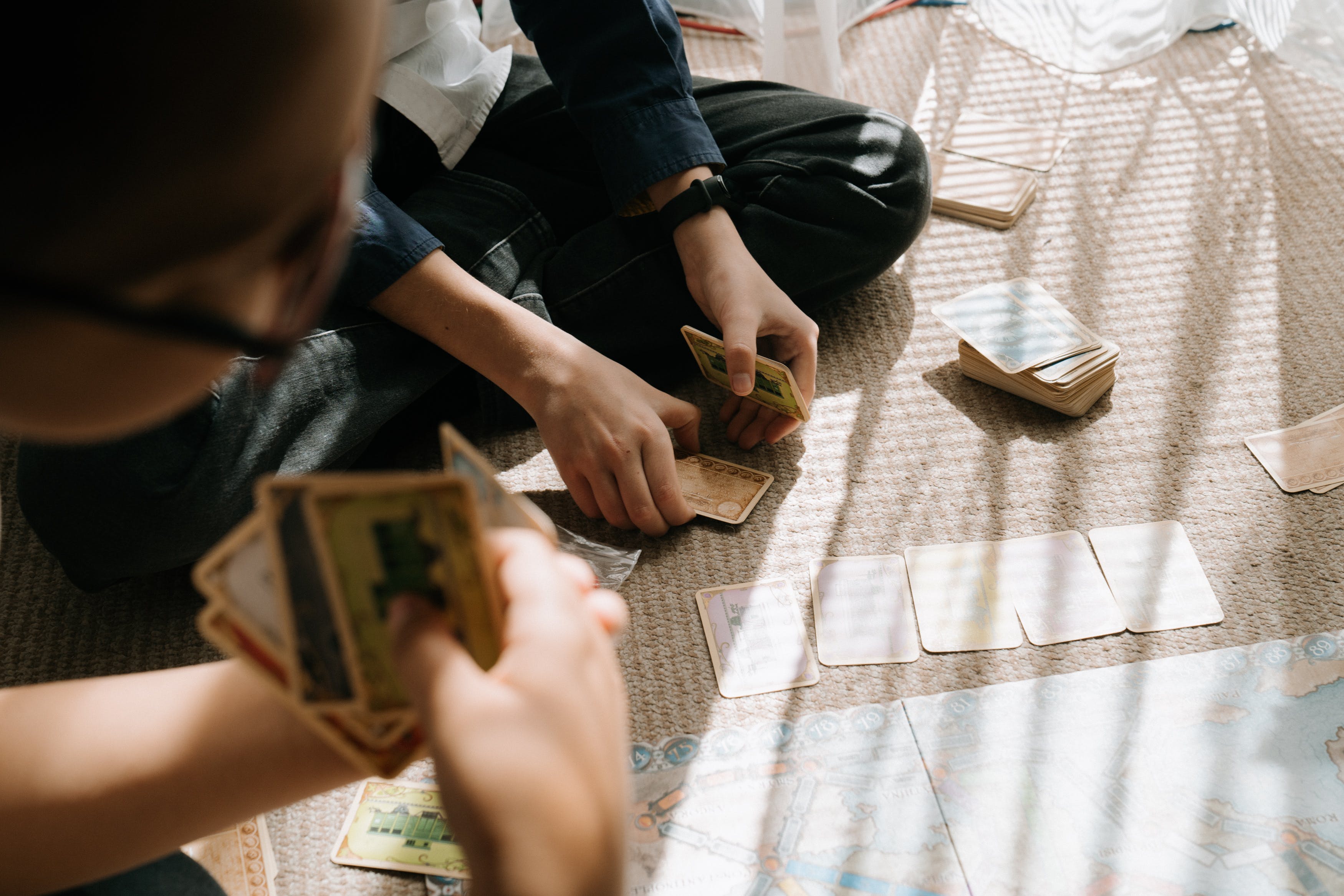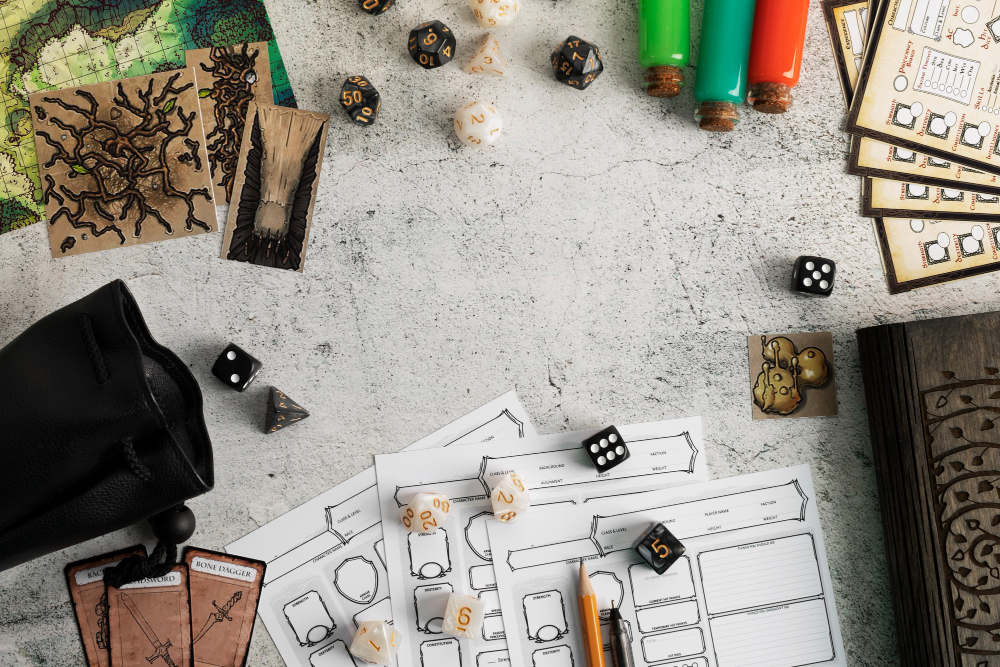In this blog post, we will share some tips on how to playtest your own board game, even when you have no other people to play with directly.
Playtest your game… on your own?
Yes! Even if it seems counterproductive, one of the simplest ways to playtest your own board game is to play it by yourself, taking on the roles of different players.
This can help you check the basic functionality of your game, such as the rules, the components, the balance, and the flow and also spot any errors or loopholes in your game design.

Some things to have in mind:
To solo playtest your game, you will need to set up the game as if you were playing with other players, and then take turns for each player, following the rules and making decisions as best as you can:
- Utiliza dice, cards, or other randomizers to simulate the actions or preferences of other players.
- Utiliza different strategies or personalities for each player, such as aggressive, defensive, cooperative, or competitive.
As you play, you should take notes of your observations, questions, and suggestions:
- As you play document the game, the actions, and the outcomes of each turn, using a spreadsheet, a camera, or a voice recorder.
- This will help you analyze the game data later and identify any issues or areas for improvement.
Downsides:
Solo playtesting can be useful for testing the core mechanics and the overall feel of your game, but it has some limitations:
- You may not be able to capture the social or emotional aspects of your game, such as the interaction, the tension, or the fun.
- It’s very easy to become biased or influenced by your own knowledge and expectations of the game, which may affect your decisions and judgments.
- Solo playtesting should not be the only method you use to test your game, but rather a complement to other methods.
Online Playtesting
Another way to playtest your own board game is to use online platforms and tools that allow you to create and share your game with other players. This can help you reach a wider and more diverse audience, get more feedback, and test your game in different scenarios and settings.

There are two main ways to make your game testable online:
Creating a print-and-play version:
- A print-and-play version is a PDF file that contains the rules and the components of your game.
- Players can download, print, cut, and assemble to play your game.
- Remember when you start designing to optimize your file size, resolution, and format.
- This is important so when you are ready to print your game it will look it’s best.
- To create a print-and-play version of your game, you will need to use a software that allows you to design and edit your game components, such as Canva, Photoshop, or Tabletop Creator.
Create a digital version:
A digital version is a file that can be imported and played on a virtual tabletop simulator, such as Tabletop Simulator, Tabletopia, or Board Game Arena.
- If you want to easily export your game, Tabletop Creator allows you to generate a game file compatible with Tabletop Simulator so you can very easily test your game.
Collecting feedback:
- Once you have created your online version of your game, you will need to share it with potential playtesters.
- You can do this by posting your game on online forums, groups, or communities, such as BoardGameGeek, Reddit, Facebook, or Discord.
- You can also join online events, such as conventions, festivals, or jams, where you can showcase your game and get feedback from other designers and players.
- When you share your game online, you should also provide a feedback form for players to submit their comments and suggestions.
- You can use a software that allows you to create and manage online surveys, such as Google Forms or Forms (Office 365).
- Include some questions that are specific to your game, such as the theme, the mechanics, the balance, the difficulty, and fun levels.
Online playtesting can be useful for testing your game with a larger and more varied sample of players, but it also has some challenges.
- Online playtesting should not be the only method you use to test your game.
- You may not be able to observe or interact with the players directly or see all their reactions through a web cam.
- This may limit your understanding of their experience and behavior.
- Technical issues, such as bugs, glitches, or compatibility problems may appear, which will inevitably affect gameplay and your understanding of their experience.
Playtesting in person with friends and family
Playtesting is a crucial step in the board game design process. It allows you to test your game mechanics, balance, theme, and fun factor with real players. Playtesting in person with friends and family can be a great way to get honest feedback, improve your game, and have fun at the same time.
Here are some tips to make the most of your playtesting sessions [click for more]:
1 – Choose your playtesters wisely.
Not all friends and family members are suitable playtesters for your game. You want to select people who are interested in your game genre, have some experience with board games, and are willing to give constructive criticism. Avoid people who are too biased, too polite, or too harsh.
2 – Prepare your prototype and rulebook.
Before you invite your playtesters, make sure your prototype is ready and playable. It doesn’t have to be perfect, but it should be clear, functional, and appealing. You also need to have a written rulebook that explains the game rules, components, setup, and gameplay. The rulebook should be concise, accurate, and easy to follow.
3 – Teach your game and observe.
When your playtesters arrive, teach them how to play your game using your rulebook. Try to avoid explaining too much or giving hints. Let them discover the game by themselves. Observe how they play, react, and interact with the game and each other. Take notes of any issues, questions, comments, or suggestions they have.
4 – Ask for feedback and listen.
After the game is over, ask your playtesters for their feedback. You can use a feedback form, a questionnaire, or an open discussion. Ask them what they liked, disliked, and would change about the game. Listen to their opinions and perspectives, but don’t take them personally or defensively. Thank them for their time and input.
5 – Analyze and iterate
Review your notes and feedback from the playtest. Identify the strengths and weaknesses of your game. Decide what aspects need to be improved, changed, or removed. Make the necessary adjustments and test your game again. Repeat this process until you are satisfied with your game.

Playtesting in person with friends and family can be a rewarding and enjoyable experience. It can help you create a better game and strengthen your relationships. However, it’s not the only way to playtest your game.
You can also attend public events, such as Protospiel o Protos y Tipos (Spain), to showcase your game and get feedback from other designers and publishers.
Hire a Company to Play Test Your Game
Here are some examples of playtesting companies for board games:
The Player Lair:
This company specializes in playtesting board games at various stages of development, from early prototypes to final artwork. They have a team of playtesters who have worked with publishers like Garphill Games, Jacob’s Brick Games, NiNi Games, and many more. They offer different packages and prices depending on your needs and budget.
Paper Weight Games
If the reviews at Board Game Geek are anything to go by, this freelance game designer is a trusted option to playtest your game. You’ll get a highly detailed review of your game to ensure the best player experience. They also can help out with rule and content revision services.
Board Game Design Lab:
This is not a company, but a community of board game designers and playtesters. They have a website, a podcast, and a Facebook group where you can find resources, tips, and advice on playtesting your game. They also organize online and offline events where you can meet and playtest with other designers and playtesters.
Conclusión
So wrapping up, remember that playtesting isn’t just a task but a journey in crafting a game. Effective playtesting is vital for successful board game design, and there are diverse methods to facilitate this process even in the absence of a local gaming community. Embrace the solo sessions where you wear different player hats, navigating rules and balance.
When you bring it home to friends and family, it’s not just about rules; it’s about having fun while getting genuine feedback. Whether utilizing personal efforts or professional services, a thorough playtesting approach ensures a well-rounded evaluation of a board game’s mechanics and overall design.


